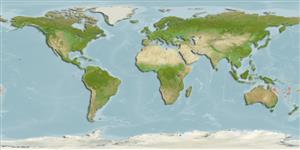Classification / Names
Populärnamn | synonymer | Catalog of Fishes(Släkte, Arter) | ITIS | CoL | WoRMS | Cloffa
>
Eupercaria/misc (Various families in series Eupercaria) >
Cepolidae (Bandfishes) > Owstoniinae
Etymology: Owstonia: Named for Alan Owston (1853‒1915), an amateur naturalist, yachtsman and collector of Asian wildlife, notably fishes from Japan and China.; hastata: Name from Latin 'hastatus' for spear-shaped, referring to the lanceolate caudal fin..
Environment: milieu / climate zone / depth range / distribution range
Ekologi
marina bottenlevande; djupintervall 228 - 260 m (Ref. 119093). Tropical
Utbredning
Länder | FAO områden | Ekosystem | Förekomster | Point map | Utplanteringar | Faunafri
Western Pacific: Australia (Queensland).
Size / Vikt / Age
Maturity: Lm ? range ? - ? cm
Max length : 13.3 cm SL hane/ej könsbestämd; (Ref. 119093)
Life cycle and mating behavior
Maturities | Reproduktion | Spawnings | Egg(s) | Fecundities | Larver
Smith-Vaniz, W.F. and G.D. Johnson, 2016. Hidden diversity in deep-water bandfishes: review of Owstonia with descriptions of twenty-one new species (Teleostei: Cepolidae: Owstoniinae). Zootaxa 4187(1):1-103. (Ref. 119093)
IUCN Red List Status (Ref. 130435)
Threat to humans
Harmless
Human uses
Verktyg
Special reports
Download XML
Internet-källor
Estimates based on models
Phylogenetic diversity index (Ref.
82804): PD
50 = 0.5000 [Uniqueness, from 0.5 = low to 2.0 = high].
Bayesian length-weight: a=0.00389 (0.00180 - 0.00842), b=3.12 (2.94 - 3.30), in cm total length, based on all LWR estimates for this body shape (Ref.
93245).
Trofisk nivå (Ref.
69278): 3.3 ±0.4 se; based on size and trophs of closest relatives
Resiliens (Ref.
120179): Hög, lägsta populationsfördubblingstid mindre än 15 månader (Preliminary K or Fecundity.).
Fishing Vulnerability (Ref.
59153): Low vulnerability (10 of 100).
